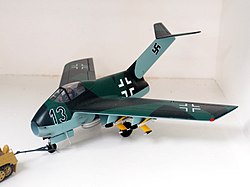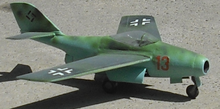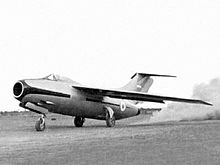Focke-Wulf Ta 183
| Focke-Wulf Ta 183 Huckebein | |
|---|---|
 Model of the Focke-Wulf Ta 183 A |
|
| Type: | Fighter aircraft , interceptor and fighter-bomber |
| Design country: | |
| Manufacturer: | |
The Focke-Wulf Ta 183 Huckebein (also Focke-Wulf Jäger Project VI ) was a German jet fighter project from the Second World War .
It is a single-engine, single-seat aircraft, the wings of which were swept , which had a pressurized cabin and was armed with cannons . It was equipped with a retractable nose wheel landing gear.
Ta 183 draft I and II
The design was based on concept studies by Hans Multhopp for the Jäger-Projekt VI by Focke-Wulf (designation after Nowarra, Wagner uses the designation PV) from 1942 to 1943, which, however, were not implemented. In order to better distinguish the different designs, this design was later often referred to as Ta 183 Design I. A development contract for a 1000 km / h fighter aircraft was tendered as early as mid-1944 . As part of the hunter emergency program of autumn 1944, the Ta 183 Design II was presented at a comparison meeting at the DVL on December 19, 1944 at the suggestion of Kurt Tank and accepted in February 1945.
Technical specifications
| Parameter | Data |
|---|---|
| crew | 1 |
| length | 9.20 m |
| span | 10 m at a 40 ° sweep |
| height | 3.86 m |
| Wing area | 22.50 m² |
| Empty mass | 2380 kg |
| Takeoff mass | 5100 kg (of which 1565 kg fuel) |
| Wing loading | 196 kg / m² |
| Top speed | 962 km / h |
| Service ceiling | 14,000 m |
| Range | |
| Engine | a Heinkel-Hirth HeS 109-011 A-0 jet engine with 1300 kp thrust |
| Armament | 4 × MK 108 , 2 × SC-500 or SD-500 bombs, 1 × BT 200 , 5 × high-explosive bombs thick-walled , or 4 × X-4 rockets |
Ta 183 draft III
Compared to the original design, which provided for a T-tail unit and the installation of the armament in the bow below the engine inlet, the final "Draft III" of the Ta 183 showed a conventional tail unit, a fuselage with a cabin moved further towards the center of the fuselage, newly designed wings and Cannons above the engine inlet. In March 1945, 16 pre-production models were ordered. Since the desired He-S-011 jet turbine was not yet available, the prototypes V0 to V4 were to be equipped with a Jumo-004 B jet engine. The first flight was planned for May / June 1945. On April 8, 1945, the development offices were occupied by the Allies and work on the first pre-production model was not finished.
More designs
Some of the findings of this development work, including that of the Messerschmitt P.1101 , such as the advantages of the wing swept, were used in the development of the second generation jet aircraft such as the MiG-15 , Saab 29 Tunnan , the North American F-86 or that of Kurt Tank from 1947 in Argentina, Pulqui II .
See also
literature
- David Myhra: Focke-Wulf Ta 183. Schiffer Publishing, Atglen PA 1999, ISBN 0-7643-0907-2 ( X Planes of the Third Reich ).
- Heinz J. Nowarra : The German air armament. Volume 2. Bernard & Graefe Verlag Koblenz 1993, ISBN 3-7637-5466-0 , pp. 114-117.
- Wolfgang Wagner: Kurt Tank - designer and test pilot at Focke-Wulf. Bernard & Graefe Verlag, Koblenz 1980, ISBN 3-7637-5271-4 ( Die Deutsche Luftfahrt 1).
- Dietmar Hermann: At the edge of the sound barrier - Focke-Wulf sends the Ta 183 into the race. In: Jet & Prop, May / June 2017, pp. 38–44.


